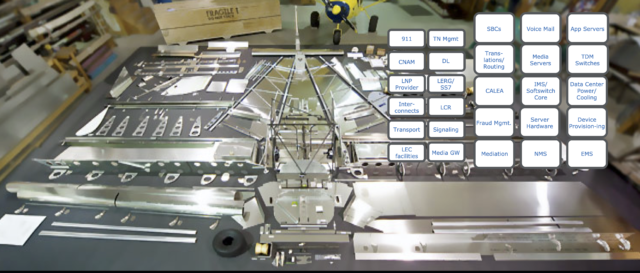It had a good life, but it’s time for a softswitch replacement. For many technological innovations, what was considered state-of-the-art 15 or 20 years go has now gotten to the point where end of life is looming large. Softswitches are no exception. They may morph to a virtual form, but in reality the risks are still very real.
Let’s start with the anatomy of a softswitch. Fundamentally speaking, the VoIP softswitch came into being more than two decades ago as the shift from purpose-built hardware to software driven appliances for telecom took effect. The constituent components, applications, and subsystems ranged from a half-dozen to 20 or 30 or more, depending on the vintage and origins of the underlying platform.
My analogy for building your own telecom solution (softswitch or otherwise) is akin to buying a model airplane kit: (more than) some assembly and a lot of subject matter expertise required!

In theory, this software revolution aimed to make operating a telecommunications solution easier—and it did, at least to the extent that it took a lot of the dependence on the aforementioned purpose-built hardware out of the equation. What it didn’t do, however, was remove the actual complexity of stitching together the components into a working solution.
Fast forward to the age of Network Functions Virtualization (NFV), which took some more of the hardware sting out by commoditizing the physical platforms on which the software executed. But even NFV comes with its own complexity. For example, probing on a hardware-based platform was pretty straightforward: you plugged into the appropriate span port on the device and voila! When the devices are virtual, it’s a tad more difficult—especially with multiple applications executing on the same virtual machine.
And the thing that all these of platform and technology iterations have in common: At some point they all reach End of Life.
End of Life Nuances
End-of-life is a broad term. There are a couple of distinctions that will affect when you should start to contemplate taking action. The specific dates associated with each of these are important due to their implications.
- End of Sale: As the name implies, this is the date after which buying the product in question directly from the original vendor is no longer possible. You may still be able to source from third-party vendors or marketplaces (eBay!), but the product itself is no longer offered from the OEM. You may also see the term EOA, or “end of availability.”
- End of Life: Basically, the vendor has decided that the product (hardware or software) has lived out its design intent (some might say “planned obsolescence”) and, effective on the EOL date, they will suspend marketing, offer “last chance buying,” and minimize or cease any sustaining efforts.
- End of Service Life: At this point, the original vendor doesn’t want anything to do with that product, often because the cost of supporting or sustaining software, or even getting hardware components, is untenable. This means no more support calls—although you may find some third-party to help. Now you enter the wild woolly world of the grey/aftermarket ecosystem (yes, believe it or not, you can still get DMS100 line cards on eBay…but would you?).
Softswitch Operational Risks
Setting aside any business-case comparisons for alternatives to building and maintaining your own voice platform here, there’s operational risks and exposures in keeping your softswitch. Even if the product itself is not EOL just yet, there are some valid operational risks to consider.
- Aging workforce: Let’s face it, there aren’t a lot of fresh bodies coming into the telecom industry saying “Ooh, let me work on that 20-year-old softswitch!” The resource pool is aging, and there’s going to be a pretty large exodus (voluntary or otherwise) as vendors re-focus their portfolios to the next big thing. Do you have a contingency should your “switch guru” exit?
- Single point of failure: Not necessarily in the softswitch itself as vendors have done a great job of applying the carrier grade ethos to the softswitch world. The point of failure comes from having a single switch in a single site. Of course, there are many service providers that have geo-split two halves of a switch, but those tend to be from one side of a city to the other. Very few have the wherewithal and scale to implement a nationwide active-active geo-redundant solution.
Ditch the Switch and Embrace the Cloud
Cloud communication platforms address all these short comings and provide a future-proof, feature-rich software solution to support current customer needs and allow you to address them as technology and market demands shift.
- Easy to manage. Fewer people, lower technical skills needed (you are not engineering SS7 networks, updating LERG, etc.). Those skilled resources are better used on other initiatives (broadband, thinking of new products).
- You don’t sacrifice “carrier grade” just because it’s cloud. True cloud architecture is highly resilient with an active-active, geo redundant architecture without a single point of failure.
- Easy to scale up and down, operationally and financially. You don’t have to deal with stranded capital in underutilized resources.
- The last switch migration—ever!
- Lower total cost of ownership. In most cases, when all the true costs of operating your own switch are factored in, a cloud communications platform will deliver meaningful savings with a lower TCO.
In Summary
Following my airplane analogy at the start of this post, a cloud communications platform is more like operating an airplane that is already integrated and ready to fly! You don’t have to buy and assemble all the components, carry spare parts, or worry about when it will be obsolete as new capabilities are added automatically. You only have to decide how many seats you want your airplane to hold.
Interested in de-risking your VoIP and cloud communications solution? Let’s talk!



